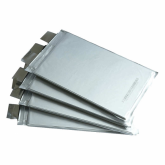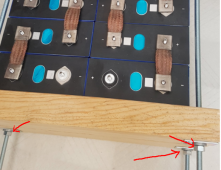Work-in-progress!
This wiki has not yet been approved, see
https://diysolarforum.com/threads/pouch-compression-wiki-review.20893/
This is an advanced topic regarding maximizing the cycle-life of lithium pouch cells. For more see this
thread and this
thread.
Lithium pouch cells are often sandwiched together in plastic or aluminum cases:
Pouch cells
 | A Nissan Leaf module cut away to show pouch cells inside:
 |
In application, lithium-ion pouch-format cells undergo 6% expansion during cycling. To prevent contact loss between battery pack components and delamination and deformation during battery operation, compressive pressure is applied to cells in automotive battery modules/packs by way of rigid cell housing within the modules. Normal cell expansion occurs based on temperature and the state of charge. Over time, gas is released from the battery as it ages which also affects the expansion.
In
experiments, Lithium-ion capacity fade after 1200 cycles for 0, 5, and 15 psi compression was found to be: 11%, 8.8%, and 8.4%. Note that the effect is impacted by the charge/discharge rates and with low rates, as common in solar storage, may be of lesser importance.
ghostwriter66 spoke to a senior design architect for EVE and
reported these takeaways for LFP:
- a dramatic increase (1.6x) in longevity occurred at 12 PSI, 50% SoC, and at 72°F/22°C
- 12PSI could change rapidly as the temperature of the battery and SOC changed
- Any compression is better than no compression. BUT NO compression is better than compressing it above 18 PSI.
- Below 72°F the fading effect is linear with compression. Over 72°F the effect decreases exponentially.
(note: Although this paper indicates, with NMC, compression is more beneficial at high temperatures than low.)
- A pressure-inducing system (e.g., constant-force-spring loaded plate) that could keep the cells at a constant 12 psi as temperature changes would be ideal.
Compression Springs
When compressing cells, you can put compression springs where
the arrows are shown in the picture to the right. See also
noenegdod's version.
Compression springs aren't a perfect solution as they follow Hooke's law,
which is the force changes based on the length, and the length changes
as the system expands and contracts. But, a long compression spring can
compensate for the short range of motion in this application.
Steel rods are very strong and will not stretch or expand/contract much
unless very long or exposed to large temperature swings. | |
The more cells there are in a row the greater the effect is. The threaded rods aren't going to expand/contract much as they're not subject to the same thermal loads (and different materials expand/contract at different rates).
Let's say each of the 8 cells expands and contracts 0.25 mm, so with 8 cells in a row that's
2mm overall. If neither the cell nor the bars were compressible the pressure would be enormous.
Example Math
What size compression spring for two rows of 8 cells, a combined surface area of 300 in².
The calculation is to take the surface area of the battery and multiply it by the desired psi.
In this example, the two rows of cells have a combined surface area of 300 in². For a maximum of 15 psi:
300 in² x 15 psi = 4500 lbf
Divide 4500 by 4 bolts = 1125 lb
f per bolt.
Springs are usually rated in lb
f/in and have a length. So a 3" 100 lb
f/in spring compressed 2" is applying 200 lbf.
Here's a $35
pack of 5 springs that are 2" and supply 838 lb
f/in, or 1125 lbf at 1.34". So, when the batteries were hot and at the SoC that gave the maximum expansion, you could torque them to the right pressure.
As the batteries contracted, the springs would keep pressure on them. But, that pressure would lessen the greater the overall change in length (by 838 lb
f/in). Longer compression springs at lower forces would have less pressure change.
Periodic Adjustment
This
reference indicates cell thickness has irreversible changes over time, so any compression should be periodically checked:
The second change is the cell thickness increase from BoL (beginning of life) to EoL (end of life). This change is typically not reversible. This irreversible thickness increase of the cell is gradual and happens over repetitive charge and discharge cycles... If the cells are restricted more than optimal, the capacity fade occurs faster and at the same time, it can be detrimental
Compression Foam
jmole brings up using Compression Foamhere. The idea is that a foam
separator acts like a spring, so it can be used without the need for compression springs:
Foam compresses 25% at 11psi. If you buy 1/4" foam, then plan for 3/16" between your cells when you
design your busbars and your box, and you have 11psi compression with no springs and no hassle.
|
|
Compression Sensors
fafrd reports finding found
low-cost pressure sensors that will hopefully enable him to monitor his pack.





